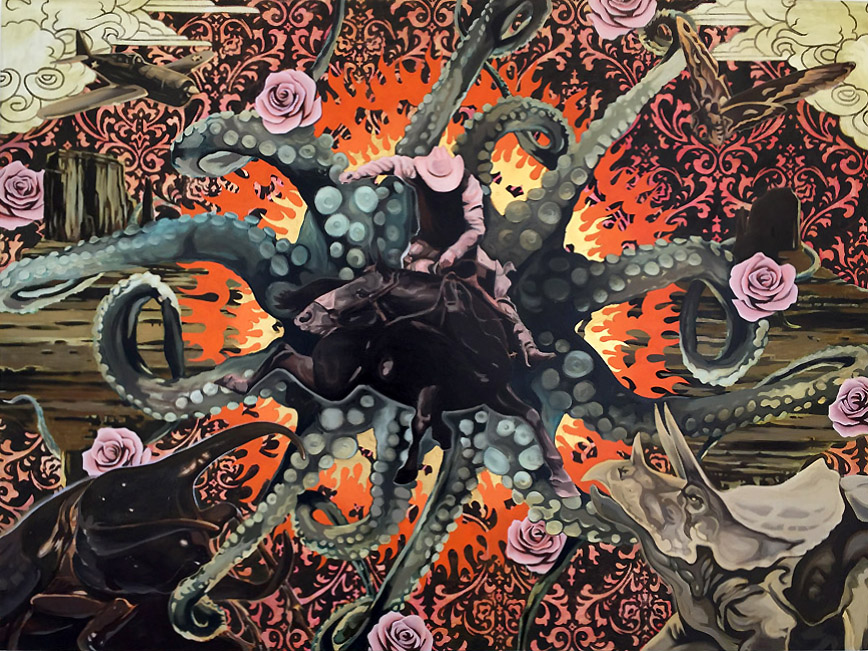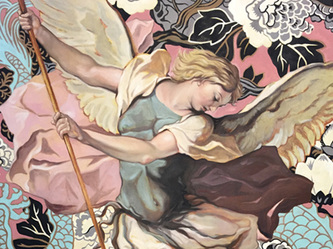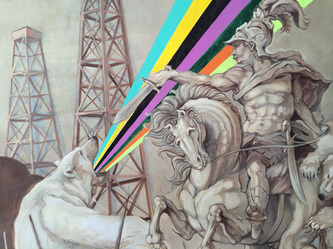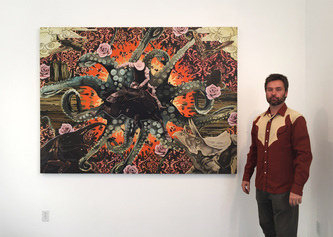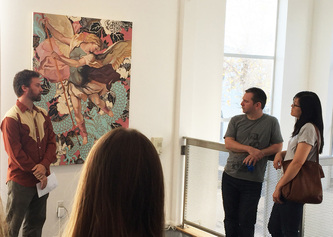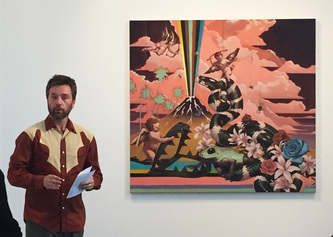Anthony Riggs
The Irreversible Triumph of Time
October 7th - November 19th, 2016
Opening Reception: Friday, October 7th, 6-9pm
Artist's Talk: Saturday, November 12th 2-3pm
Opening Reception: Friday, October 7th, 6-9pm
Artist's Talk: Saturday, November 12th 2-3pm
Transmission Gallery is pleased to present The Irreversible Triumph of Time, a solo exhibition of paintings by Anthony Riggs.
Riggs' dramatic large-scale paintings explore a cultural kaleidoscope of competing belief systems. Employing a host of mythic figures, eastern symbolism, advertising methods and televised propaganda, the ensuing mash-up engenders new narratives in visually complex worlds.
Riggs' desire for the work is to invite an examination of the relationships between east and west, masculine and feminine, ancient and modern, science and religion. The visual feast he provides allows ample opportunity to consider these relationships and many more in light of "the near scientific thinking, environmental fear, and religious beliefs found in American mainstream culture" reflected in the paintings.
The pleasure comes in loosing oneself in the imagery and color while working out an understanding of the "story" as it emerges from the canvas. Will our "unfortunate, irrational faith in reason" lead us astray? Has our vision of manifest destiny hopelessly crushed our sustaining ecology? How do we assemble colliding desires, subterranean superstitions and educated understanding into a coherent world view? Does it matter if we do?
As Riggs points out in his statement on the work, "In one canvas, science gains ground only to be thwarted by nature. In another, religion is flanked by technology. As the dust settles, we convince ourselves that this time we have made progress. Then, like some absurd cosmic joke the whole mess repeats itself. Only time is left standing victorious."
Riggs' dramatic large-scale paintings explore a cultural kaleidoscope of competing belief systems. Employing a host of mythic figures, eastern symbolism, advertising methods and televised propaganda, the ensuing mash-up engenders new narratives in visually complex worlds.
Riggs' desire for the work is to invite an examination of the relationships between east and west, masculine and feminine, ancient and modern, science and religion. The visual feast he provides allows ample opportunity to consider these relationships and many more in light of "the near scientific thinking, environmental fear, and religious beliefs found in American mainstream culture" reflected in the paintings.
The pleasure comes in loosing oneself in the imagery and color while working out an understanding of the "story" as it emerges from the canvas. Will our "unfortunate, irrational faith in reason" lead us astray? Has our vision of manifest destiny hopelessly crushed our sustaining ecology? How do we assemble colliding desires, subterranean superstitions and educated understanding into a coherent world view? Does it matter if we do?
As Riggs points out in his statement on the work, "In one canvas, science gains ground only to be thwarted by nature. In another, religion is flanked by technology. As the dust settles, we convince ourselves that this time we have made progress. Then, like some absurd cosmic joke the whole mess repeats itself. Only time is left standing victorious."
Anthony Riggs explains it all at transmission Gallery, November 12, 2016
Anthony Riggs on The Irreversible Triumph of Time:
My work explores the dark side of the history of painting. By integrating visual elements from different historical periods and ideological viewpoints, I investigate how aesthetics has been used as propaganda to control the narrative of history. I combine visual styles and imagery from multiple sources to create a dialog about the origins of our current perspectives, beliefs, and the conflicts that arise from them.
I borrow from ancient mythology, pop culture, kitsch, propaganda, religious iconography, and science fiction. Using the aesthetic tricks of classical composition and advertising propaganda, I want to seduce viewers into my narrative world. In these works, I invite the viewer to think about the relationship between east and west, masculine and feminine, ancient and modern, science and religion. I want them to question their own beliefs and ask how they might be unconsciously contributing to conflict.
The work in this show combines the scientific and environmental worldview with the appropriated aesthetics of ancient religious art, creating an iconography of an emerging belief system. These works are a reflection of the near scientific thinking, environmental fear, and religious beliefs found in American mainstream culture.
In the conflicts that play out in paint on canvas, beliefs and cultures collide. In one canvas, science gains ground only to be thwarted by nature. In another, religion is flanked by technology. As the dust settles, we convince ourselves that this time we have made progress. Then, like some absurd cosmic joke the whole mess repeats itself. Only time is left standing victorious.
My work explores the dark side of the history of painting. By integrating visual elements from different historical periods and ideological viewpoints, I investigate how aesthetics has been used as propaganda to control the narrative of history. I combine visual styles and imagery from multiple sources to create a dialog about the origins of our current perspectives, beliefs, and the conflicts that arise from them.
I borrow from ancient mythology, pop culture, kitsch, propaganda, religious iconography, and science fiction. Using the aesthetic tricks of classical composition and advertising propaganda, I want to seduce viewers into my narrative world. In these works, I invite the viewer to think about the relationship between east and west, masculine and feminine, ancient and modern, science and religion. I want them to question their own beliefs and ask how they might be unconsciously contributing to conflict.
The work in this show combines the scientific and environmental worldview with the appropriated aesthetics of ancient religious art, creating an iconography of an emerging belief system. These works are a reflection of the near scientific thinking, environmental fear, and religious beliefs found in American mainstream culture.
In the conflicts that play out in paint on canvas, beliefs and cultures collide. In one canvas, science gains ground only to be thwarted by nature. In another, religion is flanked by technology. As the dust settles, we convince ourselves that this time we have made progress. Then, like some absurd cosmic joke the whole mess repeats itself. Only time is left standing victorious.
